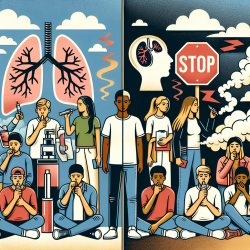Understanding the Epidemic: Youth Vaping and Respiratory Health
In recent years, the use of electronic cigarettes (e-cigarettes or vaping products) among youth has emerged as a significant public health concern. The research article "Global youth vaping and respiratory health: epidemiology, interventions, and policies" provides a comprehensive review of the epidemiology, health risks, and policy implications associated with youth vaping. This blog aims to help practitioners enhance their skills by implementing the research outcomes and encouraging further exploration into this critical issue.
Key Findings from the Research
The research highlights several alarming trends and health risks associated with youth vaping:
- Rising Prevalence: E-cigarette use among teenagers has increased significantly, with studies showing a 19% rise in usage between 2011 and 2018 in the United States alone.
- Health Risks: Vaping is linked to various respiratory health issues, including asthma exacerbations, bronchitis, and respiratory-tract irritation. Nicotine exposure can also lead to cognitive impairment and neurodevelopmental problems.
- Gateway Hypothesis: E-cigarettes may serve as a gateway to traditional cigarette smoking and other substance use, compounding health risks.
- Need for Interventions: Current public health interventions are limited, highlighting the need for more effective strategies to prevent and reduce e-cigarette use among youth.
Implementing Research Outcomes: Strategies for Practitioners
Practitioners can play a vital role in addressing youth vaping by implementing the following strategies based on the research findings:
- Enhanced Screening: Increase the frequency of screening for e-cigarette use in primary care settings. Educate healthcare providers on the importance of discussing vaping with patients, especially those with respiratory conditions like asthma.
- Educational Campaigns: Develop and distribute educational materials to raise awareness about the health risks associated with vaping. Target campaigns towards vulnerable groups, including teenagers from lower socioeconomic backgrounds and those with mental health issues.
- Collaboration and Training: Encourage collaboration between healthcare providers, public health researchers, and educators to develop comprehensive intervention programs. Provide training to practitioners on nicotine tapering and cessation support for youth.
- Policy Advocacy: Advocate for stricter policies to limit e-cigarette marketing and accessibility to minors. Support initiatives that restrict the use of enticing flavors and regulate e-cigarette sales.
Encouraging Further Research
While the research provides valuable insights, there is a clear need for ongoing investigation into the long-term effects of e-cigarette use and the development of effective interventions. Practitioners are encouraged to contribute to this growing body of research by conducting studies on the efficacy of different intervention strategies and exploring innovative approaches to prevention and cessation.
Conclusion
Addressing the youth vaping epidemic requires a multifaceted approach that combines education, intervention, and policy change. By implementing the research outcomes and advocating for further investigation, practitioners can help mitigate the health risks associated with e-cigarette use and promote better respiratory health outcomes for children and adolescents.
To read the original research paper, please follow this link: Global youth vaping and respiratory health: epidemiology, interventions, and policies.










